A Brief History Of Medicine Part 3 The


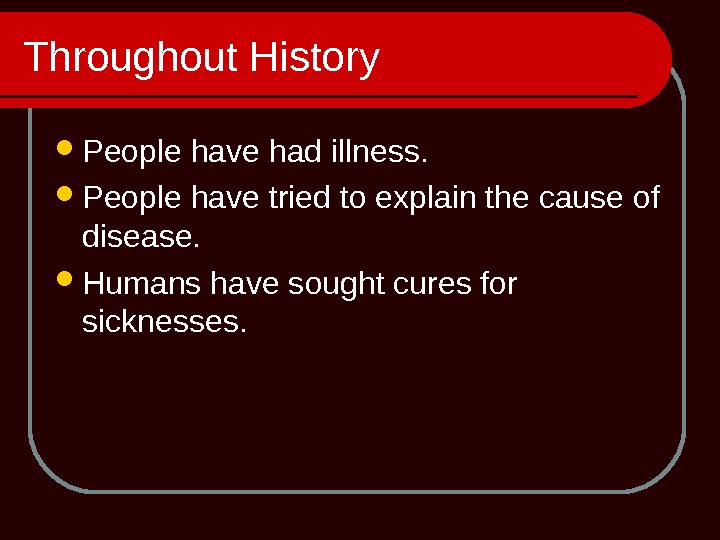


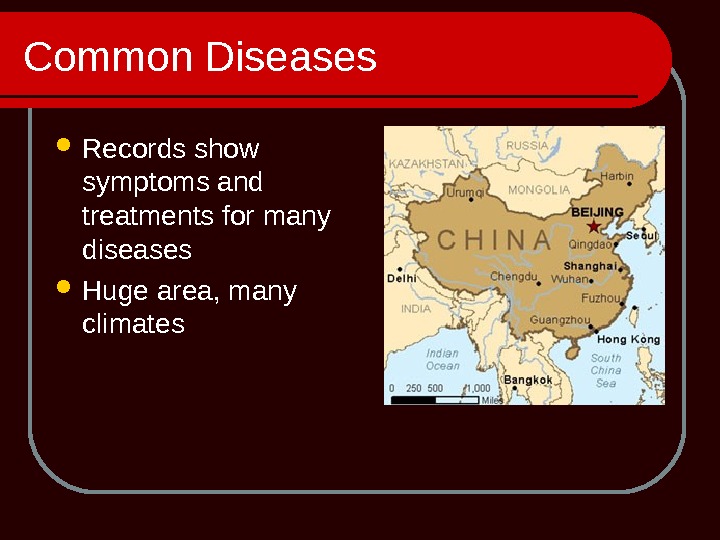
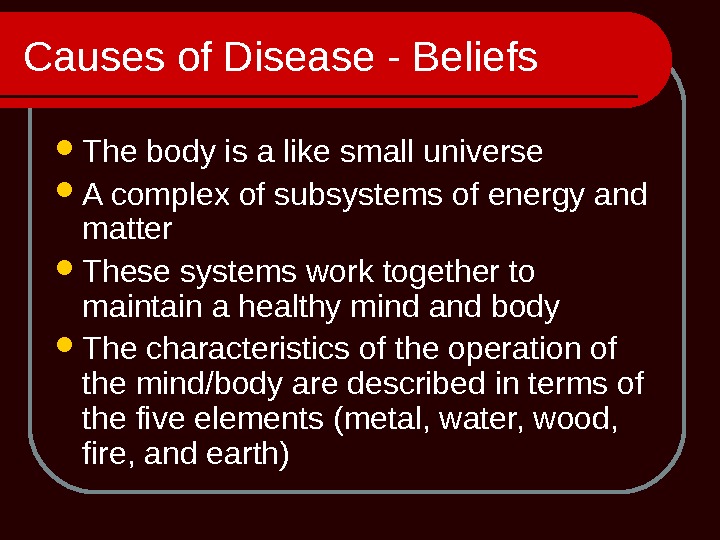
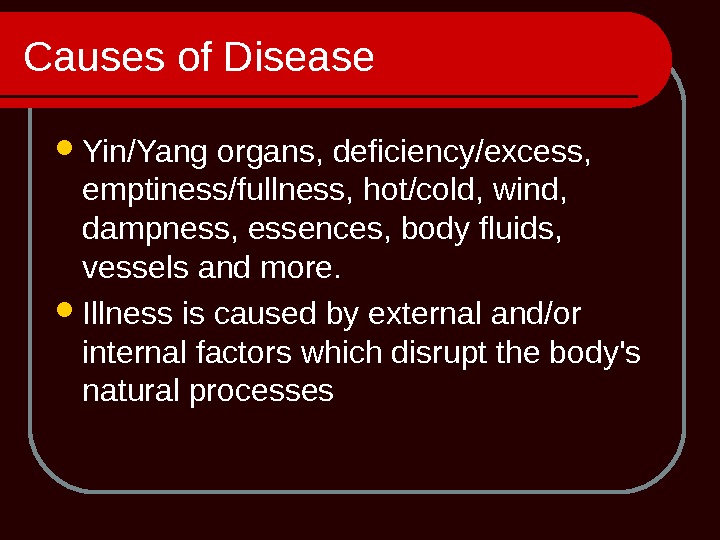


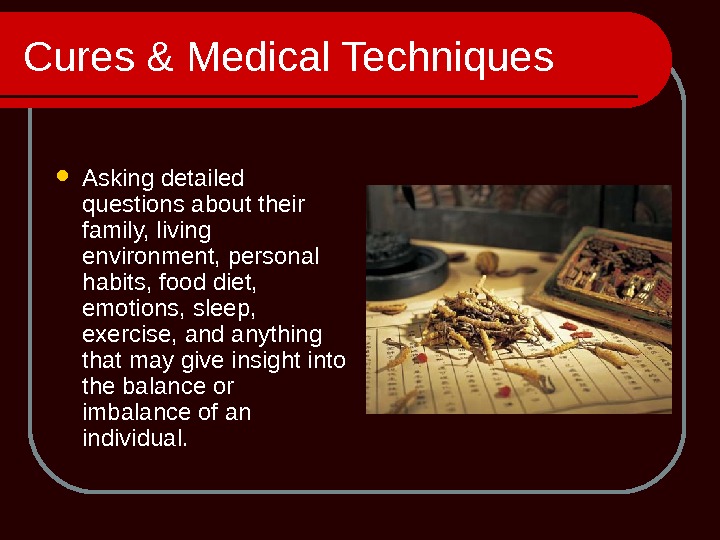
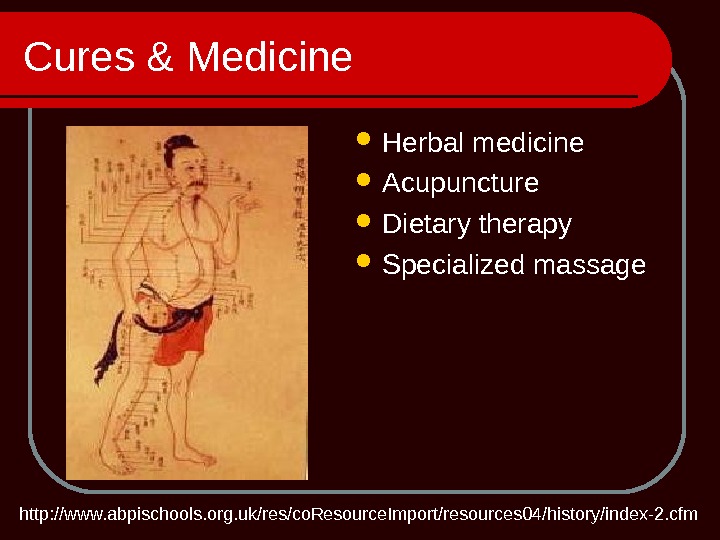

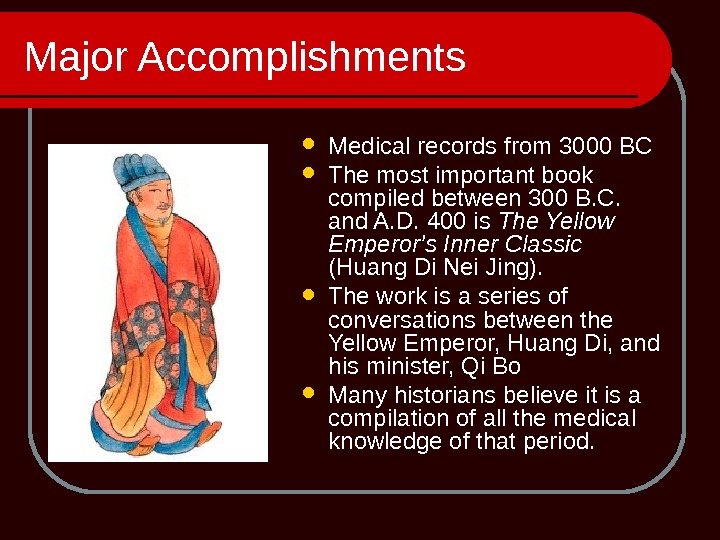



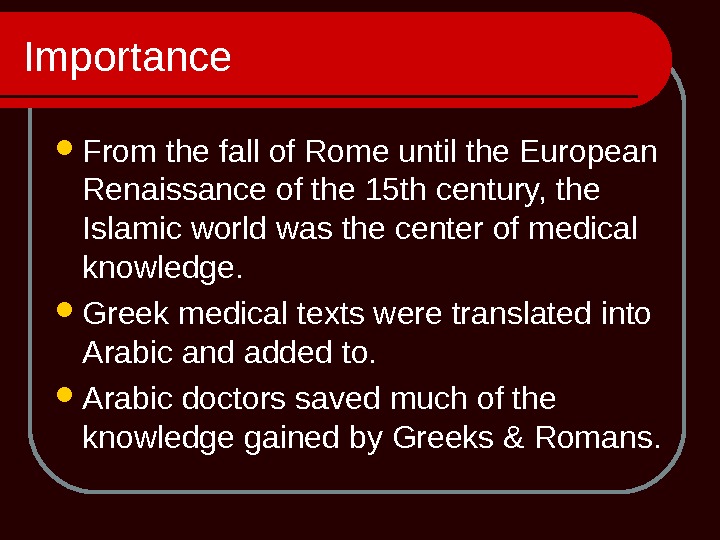
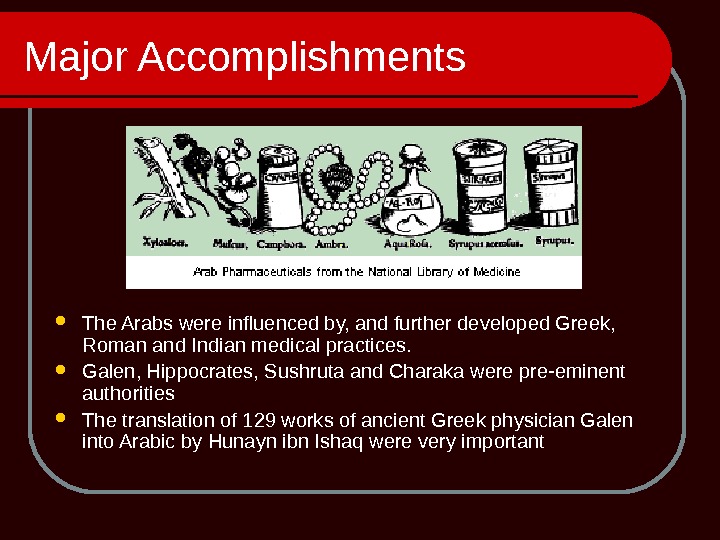




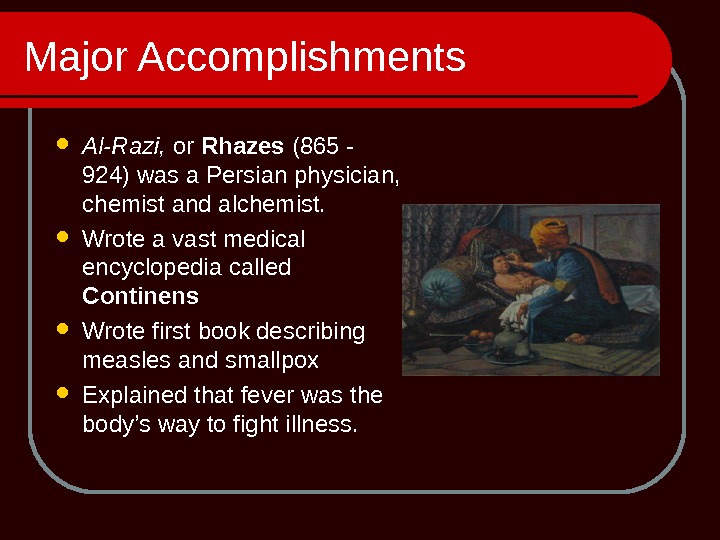
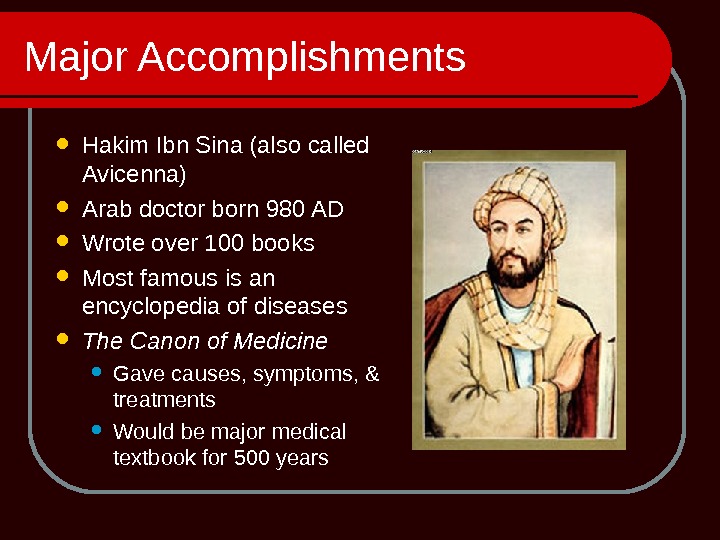
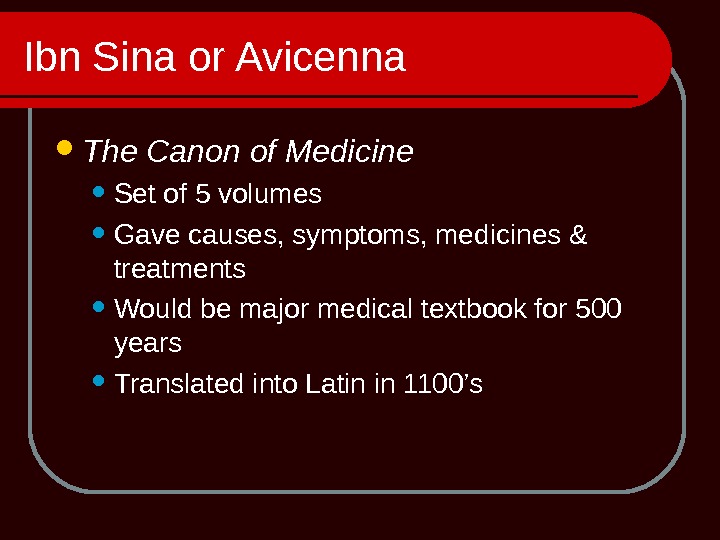
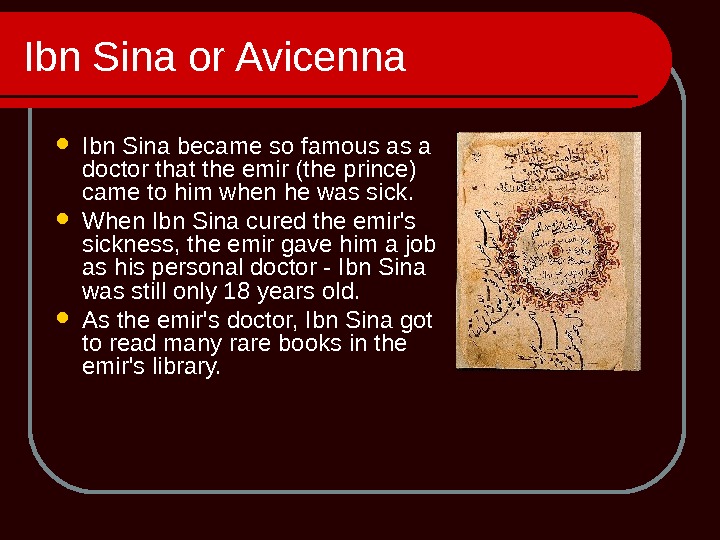
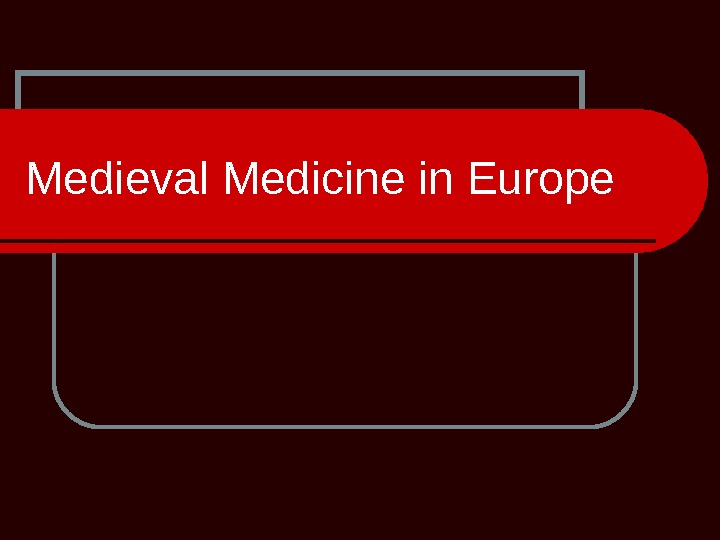




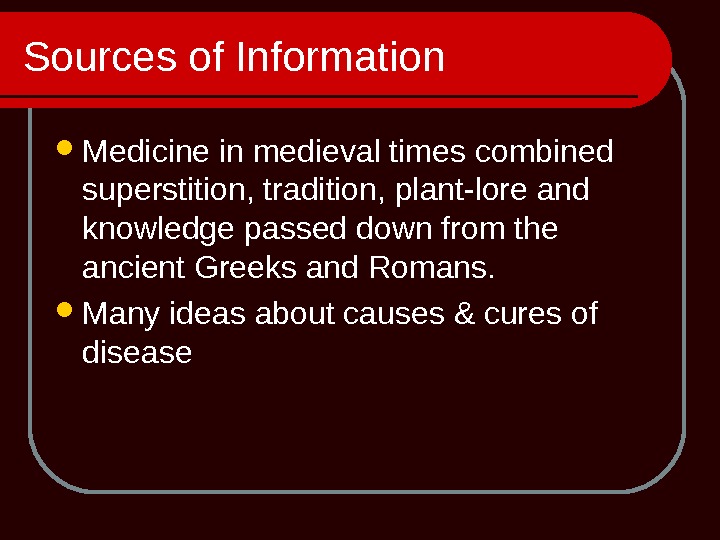

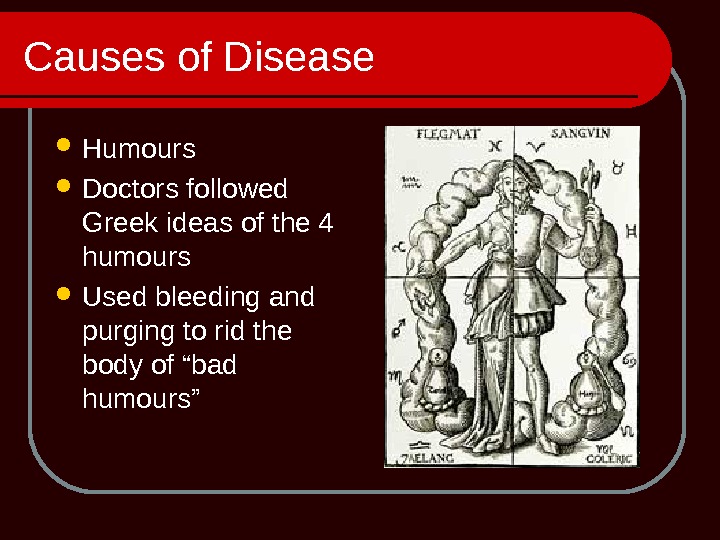

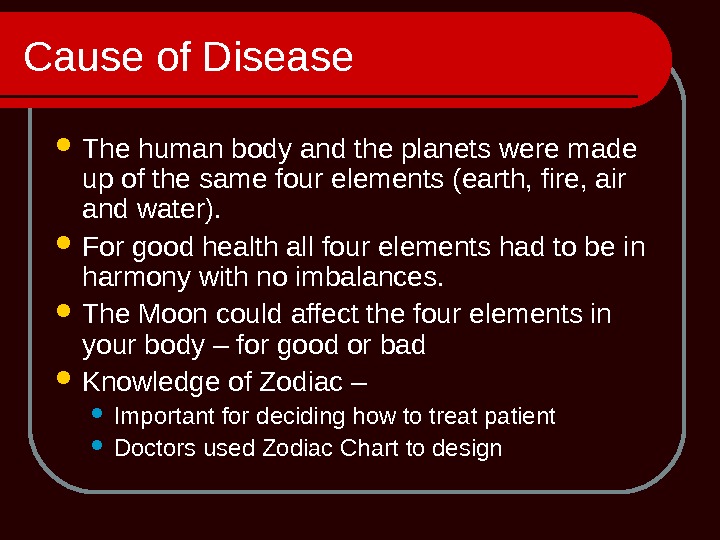



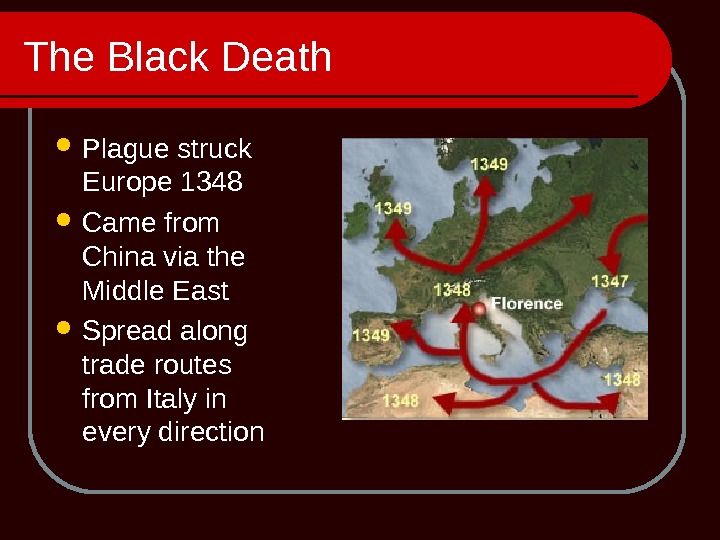
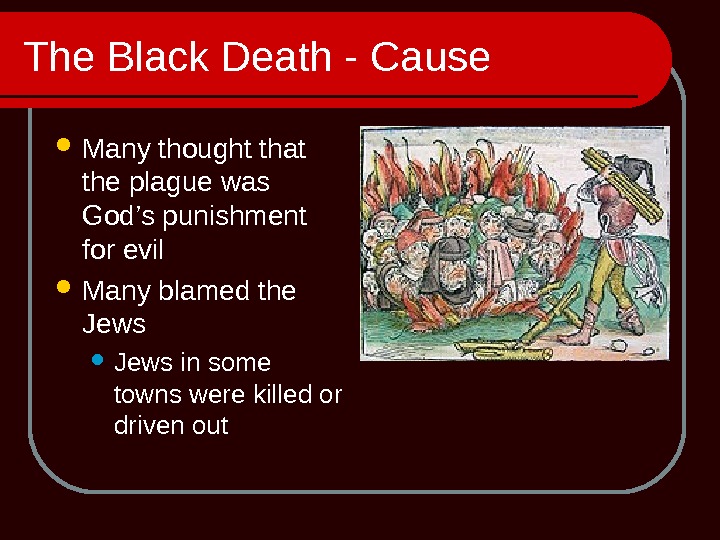


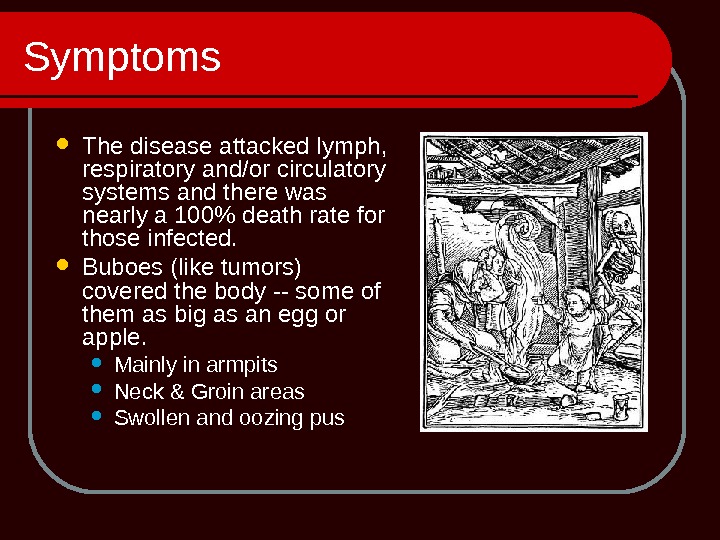
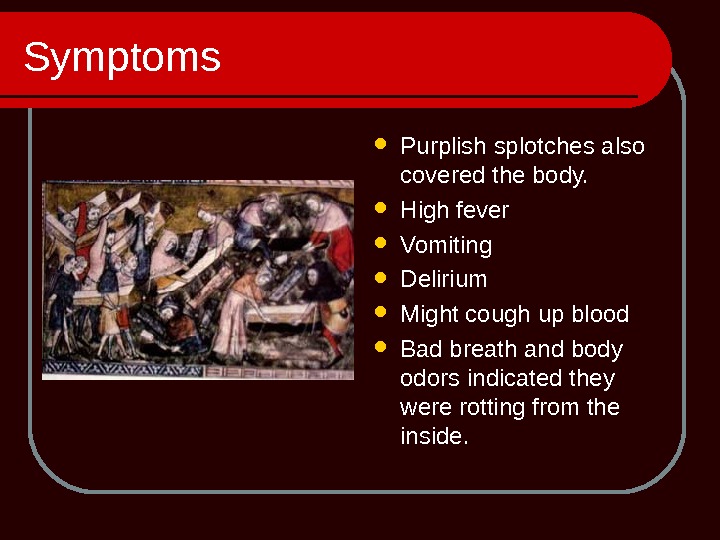
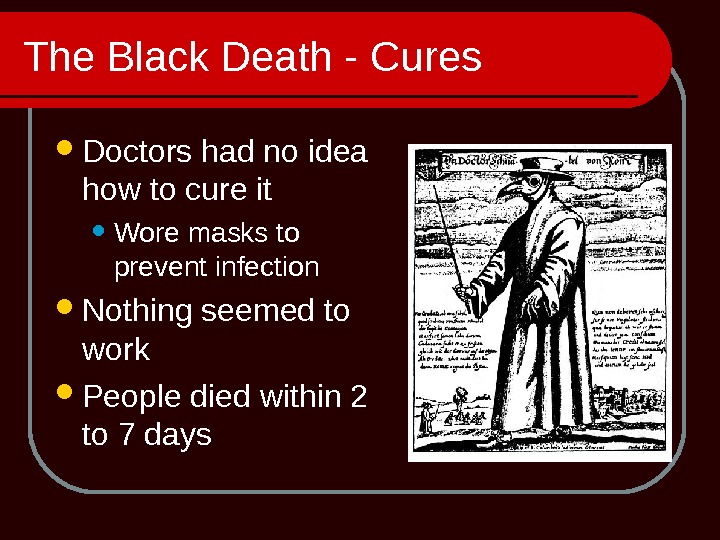
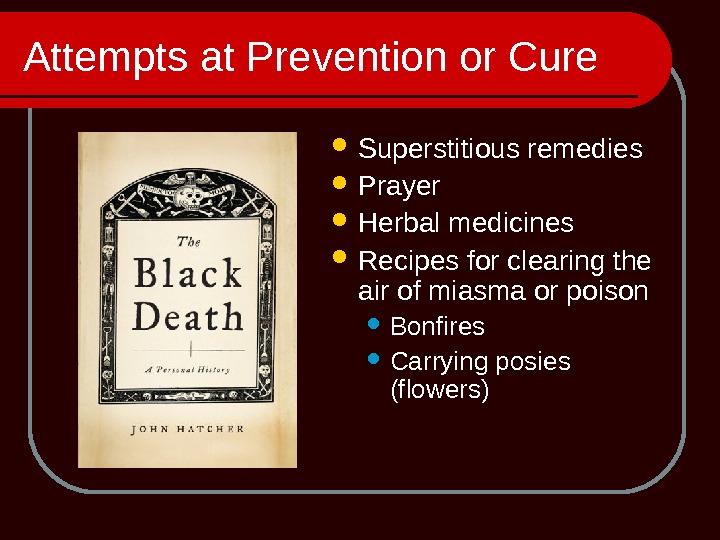
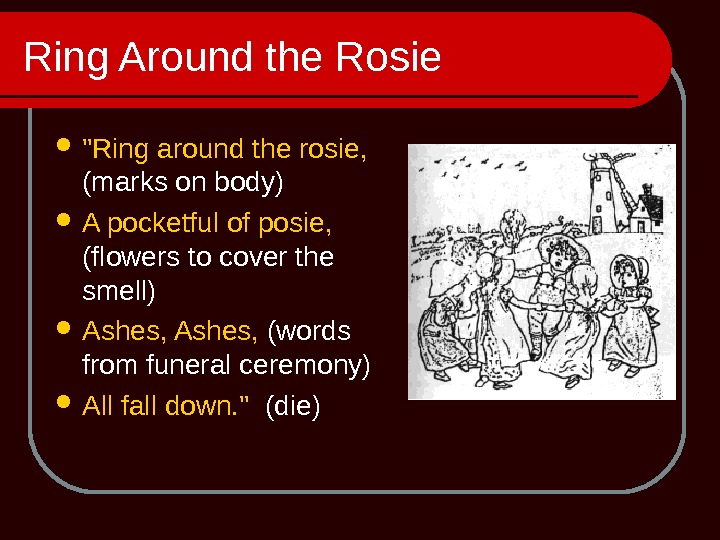
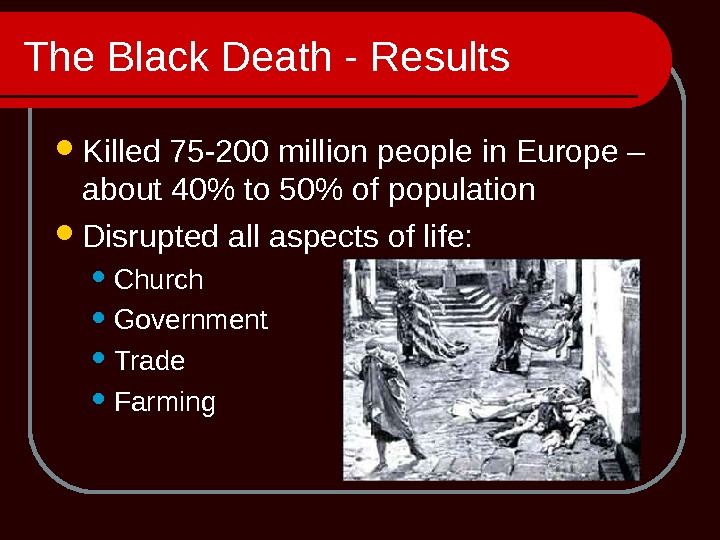

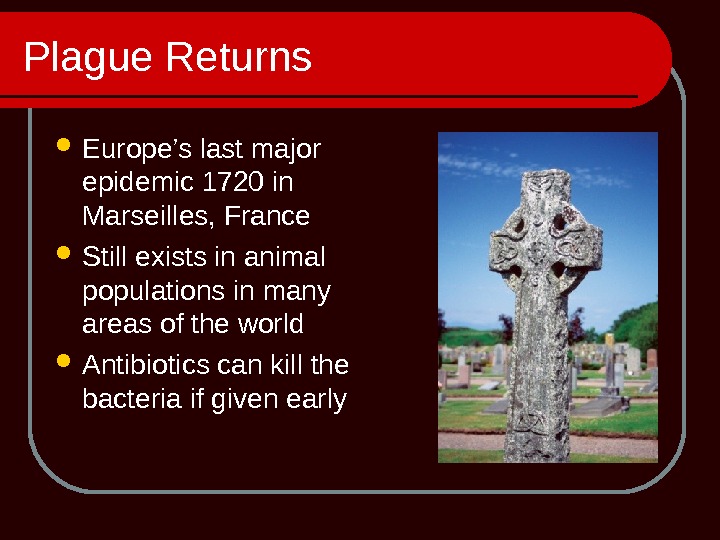
- Размер: 2.1 Mегабайта
- Количество слайдов: 51
Описание презентации A Brief History Of Medicine Part 3 The по слайдам
 A Brief History Of Medicine Part 3 The Middle Ages
A Brief History Of Medicine Part 3 The Middle Ages
 People have had illness. People have tried to explain the cause of disease. Humans have sought cures for sicknesses. Throughout History
People have had illness. People have tried to explain the cause of disease. Humans have sought cures for sicknesses. Throughout History
 Traditional Chinese Medicine
Traditional Chinese Medicine
 Time Period 500 BC to 1600 AD Many medical practices are still used today
Time Period 500 BC to 1600 AD Many medical practices are still used today
 Common Diseases Records show symptoms and treatments for many diseases Huge area, many climates
Common Diseases Records show symptoms and treatments for many diseases Huge area, many climates
 Causes of Disease — Beliefs The body is a like small universe A complex of subsystems of energy and matter These systems work together to maintain a healthy mind and body The characteristics of the operation of the mind/body are described in terms of the five elements (metal, water, wood, fire, and earth)
Causes of Disease — Beliefs The body is a like small universe A complex of subsystems of energy and matter These systems work together to maintain a healthy mind and body The characteristics of the operation of the mind/body are described in terms of the five elements (metal, water, wood, fire, and earth)
 Causes of Disease Yin/Yang organs, deficiency/excess, emptiness/fullness, hot/cold, wind, dampness, essences, body fluids, vessels and more. Illness is caused by external and/or internal factors which disrupt the body’s natural processes
Causes of Disease Yin/Yang organs, deficiency/excess, emptiness/fullness, hot/cold, wind, dampness, essences, body fluids, vessels and more. Illness is caused by external and/or internal factors which disrupt the body’s natural processes
 Cures & Medical Techniques Taking pulse in six positions Observations of patient’s tongue, voice, hair, face, posture, gait, eyes, ears, vein on index finger of small children Checking the patient’s body (especially the abdomen, chest, back, and lumbar areas) for tenderness Comparing the warmth or coolness of different parts of the body
Cures & Medical Techniques Taking pulse in six positions Observations of patient’s tongue, voice, hair, face, posture, gait, eyes, ears, vein on index finger of small children Checking the patient’s body (especially the abdomen, chest, back, and lumbar areas) for tenderness Comparing the warmth or coolness of different parts of the body
 Cures & Medical Techniques Observation of the patient’s various odors Asking the patient about the effects of their problem. Anything else that can be observed without instruments and without harming the patient
Cures & Medical Techniques Observation of the patient’s various odors Asking the patient about the effects of their problem. Anything else that can be observed without instruments and without harming the patient
 Cures & Medical Techniques Asking detailed questions about their family, living environment, personal habits, food diet, emotions, sleep, exercise, and anything that may give insight into the balance or imbalance of an individual.
Cures & Medical Techniques Asking detailed questions about their family, living environment, personal habits, food diet, emotions, sleep, exercise, and anything that may give insight into the balance or imbalance of an individual.
 Cures & Medicine Herbal medicine Acupuncture Dietary therapy Specialized massage http: //www. abpischools. org. uk/res/co. Resource. Import/resources 04/history/index-2. cfm
Cures & Medicine Herbal medicine Acupuncture Dietary therapy Specialized massage http: //www. abpischools. org. uk/res/co. Resource. Import/resources 04/history/index-2. cfm
 Major Accomplishments In 56 BC, Zhang Liang invented an instrument named «Meng» which is considered to be precursor of modern stethoscope
Major Accomplishments In 56 BC, Zhang Liang invented an instrument named «Meng» which is considered to be precursor of modern stethoscope
 Major Accomplishments Medical records from 3000 BC The most important book compiled between 300 B. C. and A. D. 400 is The Yellow Emperor’s Inner Classic (Huang Di Nei Jing). The work is a series of conversations between the Yellow Emperor, Huang Di, and his minister, Qi Bo Many historians believe it is a compilation of all the medical knowledge of that period.
Major Accomplishments Medical records from 3000 BC The most important book compiled between 300 B. C. and A. D. 400 is The Yellow Emperor’s Inner Classic (Huang Di Nei Jing). The work is a series of conversations between the Yellow Emperor, Huang Di, and his minister, Qi Bo Many historians believe it is a compilation of all the medical knowledge of that period.
 Knowledge Traveled Slowly Europe would not learn about Chinese medicine until Marco Polo visited there (around 1300 AD)
Knowledge Traveled Slowly Europe would not learn about Chinese medicine until Marco Polo visited there (around 1300 AD)
 Arabic Medicine
Arabic Medicine
 Time Period The Arab world Spain was western border India was eastern border 800 AD to 1500 AD Learned from both India and ancient Greece
Time Period The Arab world Spain was western border India was eastern border 800 AD to 1500 AD Learned from both India and ancient Greece
 Importance From the fall of Rome until the European Renaissance of the 15 th century, the Islamic world was the center of medical knowledge. Greek medical texts were translated into Arabic and added to. Arabic doctors saved much of the knowledge gained by Greeks & Romans.
Importance From the fall of Rome until the European Renaissance of the 15 th century, the Islamic world was the center of medical knowledge. Greek medical texts were translated into Arabic and added to. Arabic doctors saved much of the knowledge gained by Greeks & Romans.
 Major Accomplishments The Arabs were influenced by, and further developed Greek, Roman and Indian medical practices. Galen, Hippocrates, Sushruta and Charaka were pre-eminent authorities The translation of 129 works of ancient Greek physician Galen into Arabic by Hunayn ibn Ishaq were very important
Major Accomplishments The Arabs were influenced by, and further developed Greek, Roman and Indian medical practices. Galen, Hippocrates, Sushruta and Charaka were pre-eminent authorities The translation of 129 works of ancient Greek physician Galen into Arabic by Hunayn ibn Ishaq were very important
 Major Accomplishments Doctors studied anatomy, ophthalmology, pharmacology, pharmacy, physiology, surgery, and the pharmaceutical sciences. Physicians set up some of the earliest dedicated hospitals, which later spread to Europe during the Crusades, inspired by the hospitals in the Middle East
Major Accomplishments Doctors studied anatomy, ophthalmology, pharmacology, pharmacy, physiology, surgery, and the pharmaceutical sciences. Physicians set up some of the earliest dedicated hospitals, which later spread to Europe during the Crusades, inspired by the hospitals in the Middle East
 Hospitals Developed Large hospitals to treat the sick Cairo’s hospital treated 8000 at once High standard of care for all patients rich or poor Arabic doctors were considered the best in the world at the time
Hospitals Developed Large hospitals to treat the sick Cairo’s hospital treated 8000 at once High standard of care for all patients rich or poor Arabic doctors were considered the best in the world at the time
 Major Discoveries Use of alcohol to clean wounds Discovered first disease-causing parasite Used plaster for casts Used catgut for internal stitches Early form of anesthetics used http: //library. thinkquest. org/15569/hist-5. html
Major Discoveries Use of alcohol to clean wounds Discovered first disease-causing parasite Used plaster for casts Used catgut for internal stitches Early form of anesthetics used http: //library. thinkquest. org/15569/hist-5. html
 Inventions Surgical needle (used for removal of cataracts) Method to test safety of medicines Injection syringe Inoculation Early form of vaccination
Inventions Surgical needle (used for removal of cataracts) Method to test safety of medicines Injection syringe Inoculation Early form of vaccination
 Major Accomplishments Al-Razi, or Rhazes (865 — 924) was a Persian physician, chemist and alchemist. Wrote a vast medical encyclopedia called Continens Wrote first book describing measles and smallpox Explained that fever was the body’s way to fight illness.
Major Accomplishments Al-Razi, or Rhazes (865 — 924) was a Persian physician, chemist and alchemist. Wrote a vast medical encyclopedia called Continens Wrote first book describing measles and smallpox Explained that fever was the body’s way to fight illness.
 Major Accomplishments Hakim Ibn Sina (also called Avicenna) Arab doctor born 980 AD Wrote over 100 books Most famous is an encyclopedia of diseases The Canon of Medicine Gave causes, symptoms, & treatments Would be major medical textbook for 500 years
Major Accomplishments Hakim Ibn Sina (also called Avicenna) Arab doctor born 980 AD Wrote over 100 books Most famous is an encyclopedia of diseases The Canon of Medicine Gave causes, symptoms, & treatments Would be major medical textbook for 500 years
 Ibn Sina or Avicenna The Canon of Medicine Set of 5 volumes Gave causes, symptoms, medicines & treatments Would be major medical textbook for 500 years Translated into Latin in 1100’s
Ibn Sina or Avicenna The Canon of Medicine Set of 5 volumes Gave causes, symptoms, medicines & treatments Would be major medical textbook for 500 years Translated into Latin in 1100’s
 Ibn Sina or Avicenna Ibn Sina became so famous as a doctor that the emir (the prince) came to him when he was sick. When Ibn Sina cured the emir’s sickness, the emir gave him a job as his personal doctor — Ibn Sina was still only 18 years old. As the emir’s doctor, Ibn Sina got to read many rare books in the emir’s library.
Ibn Sina or Avicenna Ibn Sina became so famous as a doctor that the emir (the prince) came to him when he was sick. When Ibn Sina cured the emir’s sickness, the emir gave him a job as his personal doctor — Ibn Sina was still only 18 years old. As the emir’s doctor, Ibn Sina got to read many rare books in the emir’s library.
 Medieval Medicine in Europe
Medieval Medicine in Europe
 Time Period – the Dark Ages Europe 476 AD to 800 AD Period of frequent wars Catholic Church provided some stability Very little advancement in learning of any kind Few large cities Very few people ever left the town they were born in.
Time Period – the Dark Ages Europe 476 AD to 800 AD Period of frequent wars Catholic Church provided some stability Very little advancement in learning of any kind Few large cities Very few people ever left the town they were born in.
 Folk Medicine Mainly based on superstition Here are some British cures from 1100 AD: Toothache cure: chew peppercorns Snake bite cure: use a salve made of earwax & ask the priest to pray over you Breathing problems cure: chop up the liver and lungs of a fox, add to wine, drink it regularly from a church bell
Folk Medicine Mainly based on superstition Here are some British cures from 1100 AD: Toothache cure: chew peppercorns Snake bite cure: use a salve made of earwax & ask the priest to pray over you Breathing problems cure: chop up the liver and lungs of a fox, add to wine, drink it regularly from a church bell
 Middle Ages After 800 AD to 1400 AD Holy Roman Empire and beginning of modern nations
Middle Ages After 800 AD to 1400 AD Holy Roman Empire and beginning of modern nations
 Middle Ages – the Crusades 1095 to 1291 AD Series of wars between Christians and Muslims over control of the Holy Land Crusades put western Europe in contact with many new ideas.
Middle Ages – the Crusades 1095 to 1291 AD Series of wars between Christians and Muslims over control of the Holy Land Crusades put western Europe in contact with many new ideas.
 Sources of Information Medicine in medieval times combined superstition, tradition, plant-lore and knowledge passed down from the ancient Greeks and Romans. Many ideas about causes & cures of disease
Sources of Information Medicine in medieval times combined superstition, tradition, plant-lore and knowledge passed down from the ancient Greeks and Romans. Many ideas about causes & cures of disease
 Causes of Disease Spiritual Causes Catholic Church taught that sickness was a result of sinful behavior Cure was therefore prayer and greater holiness
Causes of Disease Spiritual Causes Catholic Church taught that sickness was a result of sinful behavior Cure was therefore prayer and greater holiness
 Causes of Disease Humours Doctors followed Greek ideas of the 4 humours Used bleeding and purging to rid the body of “bad humours”
Causes of Disease Humours Doctors followed Greek ideas of the 4 humours Used bleeding and purging to rid the body of “bad humours”
 Causes of Disease Miasma – “bad air” Some believed that being exposed to bad air would cause disease Cure is burning fires to burn off bad vapors Prevention by carrying good smells with you Flowers Garlic around neck Pomanders/spice balls
Causes of Disease Miasma – “bad air” Some believed that being exposed to bad air would cause disease Cure is burning fires to burn off bad vapors Prevention by carrying good smells with you Flowers Garlic around neck Pomanders/spice balls
 Cause of Disease The human body and the planets were made up of the same four elements (earth, fire, air and water). For good health all four elements had to be in harmony with no imbalances. The Moon could affect the four elements in your body – for good or bad Knowledge of Zodiac – Important for deciding how to treat patient Doctors used Zodiac Chart to design
Cause of Disease The human body and the planets were made up of the same four elements (earth, fire, air and water). For good health all four elements had to be in harmony with no imbalances. The Moon could affect the four elements in your body – for good or bad Knowledge of Zodiac – Important for deciding how to treat patient Doctors used Zodiac Chart to design
 Cures & Medicine Herbal remedies Books about herbs were written Red Book of Hergest , c. 1400 was most famous
Cures & Medicine Herbal remedies Books about herbs were written Red Book of Hergest , c. 1400 was most famous
 Major Accomplishments Building of Hospitals Most major cities Monasteries Monks provided care Medical basis Herbal remedies Spiritual basis
Major Accomplishments Building of Hospitals Most major cities Monasteries Monks provided care Medical basis Herbal remedies Spiritual basis
 Medical Education Arabic & Greek medical texts were translated into Latin Medical education schools used these Arabic and Greek books
Medical Education Arabic & Greek medical texts were translated into Latin Medical education schools used these Arabic and Greek books
 The Black Death Plague struck Europe 1348 Came from China via the Middle East Spread along trade routes from Italy in every direction
The Black Death Plague struck Europe 1348 Came from China via the Middle East Spread along trade routes from Italy in every direction
 The Black Death — Cause Many thought that the plague was God’s punishment for evil Many blamed the Jews in some towns were killed or driven out
The Black Death — Cause Many thought that the plague was God’s punishment for evil Many blamed the Jews in some towns were killed or driven out
 The Black Death – Actual Cause Bubonic plague Germ is called Yersinia pestis Carried by fleas who lived on rats Infected fleas would bite humans and transmit germ
The Black Death – Actual Cause Bubonic plague Germ is called Yersinia pestis Carried by fleas who lived on rats Infected fleas would bite humans and transmit germ
 The Black Death Plague was worse in big cities People lived close together Sanitation was very poor Rats were common
The Black Death Plague was worse in big cities People lived close together Sanitation was very poor Rats were common
 Symptoms The disease attacked lymph, respiratory and/or circulatory systems and there was nearly a 100% death rate for those infected. Buboes (like tumors) covered the body — some of them as big as an egg or apple. Mainly in armpits Neck & Groin areas Swollen and oozing pus
Symptoms The disease attacked lymph, respiratory and/or circulatory systems and there was nearly a 100% death rate for those infected. Buboes (like tumors) covered the body — some of them as big as an egg or apple. Mainly in armpits Neck & Groin areas Swollen and oozing pus
 Symptoms Purplish splotches also covered the body. High fever Vomiting Delirium Might cough up blood Bad breath and body odors indicated they were rotting from the inside.
Symptoms Purplish splotches also covered the body. High fever Vomiting Delirium Might cough up blood Bad breath and body odors indicated they were rotting from the inside.
 The Black Death — Cures Doctors had no idea how to cure it Wore masks to prevent infection Nothing seemed to work People died within 2 to 7 days
The Black Death — Cures Doctors had no idea how to cure it Wore masks to prevent infection Nothing seemed to work People died within 2 to 7 days
 Attempts at Prevention or Cure Superstitious remedies Prayer Herbal medicines Recipes for clearing the air of miasma or poison Bonfires Carrying posies (flowers)
Attempts at Prevention or Cure Superstitious remedies Prayer Herbal medicines Recipes for clearing the air of miasma or poison Bonfires Carrying posies (flowers)
 Ring Around the Rosie «Ring around the rosie, (marks on body) A pocketful of posie, (flowers to cover the smell) Ashes, (words from funeral ceremony) All fall down. » (die)
Ring Around the Rosie «Ring around the rosie, (marks on body) A pocketful of posie, (flowers to cover the smell) Ashes, (words from funeral ceremony) All fall down. » (die)
 The Black Death — Results Killed 75 -200 million people in Europe – about 40% to 50% of population Disrupted all aspects of life: Church Government Trade Farming
The Black Death — Results Killed 75 -200 million people in Europe – about 40% to 50% of population Disrupted all aspects of life: Church Government Trade Farming
 Plague Returns Disease hit somewhere every 5 to 6 years from 1350 to 1490 Plague of London 1665 was one of last major epidemics
Plague Returns Disease hit somewhere every 5 to 6 years from 1350 to 1490 Plague of London 1665 was one of last major epidemics
 Plague Returns Europe’s last major epidemic 1720 in Marseilles, France Still exists in animal populations in many areas of the world Antibiotics can kill the bacteria if given early
Plague Returns Europe’s last major epidemic 1720 in Marseilles, France Still exists in animal populations in many areas of the world Antibiotics can kill the bacteria if given early

